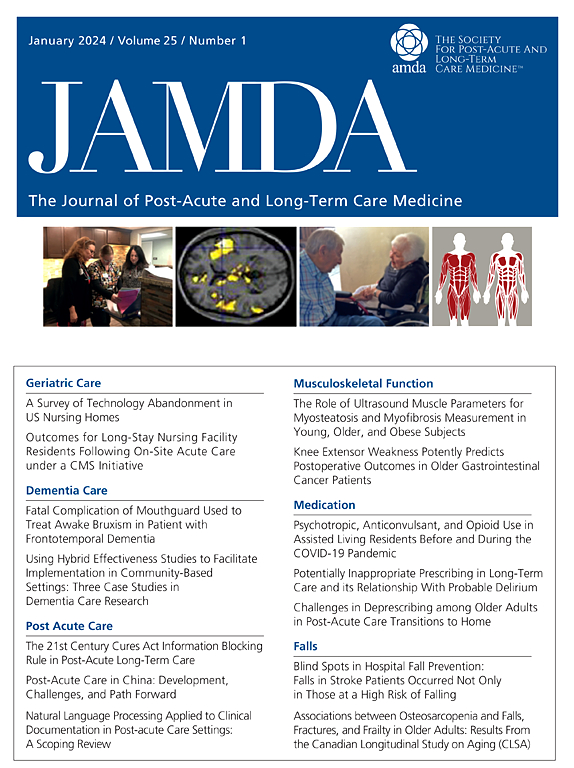Use of Paid Family Care in the Community: National Trends Among Older Adults With Functional Impairment, 2011–2022
IF 4.2
2区 医学
Q2 GERIATRICS & GERONTOLOGY
Journal of the American Medical Directors Association
Pub Date : 2025-07-23
DOI:10.1016/j.jamda.2025.105770
引用次数: 0
Abstract
Objectives
Paying family caregivers (eg, children, friends) is an innovative approach to support older adults in the community and ease direct care workforce shortages. Yet, data about the receipt of paid family care are lacking. In this study, we used a nationally representative sample of Medicare beneficiaries to (1) identify characteristics associated with receipt of paid family care in 2022, and (2) describe national trends in receipt of paid family care between 2011 and 2022.
Design
Cross-sectional study and time trend analysis.
Setting and Participants
Community-dwelling participants in the National Health and Aging Trends Study (NHATS) who reported receiving help with self-care and mobility tasks between 2011 and 2022.
Methods
We compared characteristics among those who received paid family care (vs paid nonfamily care) in 2022. We examined trends in use and hours of paid family between 2011 and 2022 using the Mann-Kendall Trend test.
Results
Of the 941 older adults who reported help with self-care or indoor mobility tasks in 2022, 30% received paid care. Of those, 28.8% received paid family (8.1% of the overall sample). This group was more likely than those with paid nonfamily care to be Medicaid-enrolled (62.5% vs 33.1%, P < .001) and have more living children (3.36 vs 2.53, P > .001). There were no significant trends in the proportion of older adults receiving paid family care between 2011 and 2022 (range from 5.9% to 8.8%). Yet during this time, hours of paid care received decreased among those with paid nonfamily care (P = .005).
Conclusions and Implications
A substantial subgroup of older Medicare beneficiaries, including both those with and without Medicaid, received paid family care between 2011 and 2022. Especially given direct care workforce shortages, evidence-based expansion of models of paid family care is an important approach to meet the care needs of older adults living in the community.
社区有偿家庭护理的使用:2011-2022年功能障碍老年人的全国趋势
目标:支付家庭照顾者(如儿童、朋友)的费用是支持社区老年人和缓解直接护理人员短缺的一种创新方法。然而,缺乏关于获得有偿家庭护理的数据。在这项研究中,我们使用了一个具有全国代表性的医疗保险受益人样本来(1)确定2022年与有偿家庭护理接收相关的特征,以及(2)描述2011年至2022年期间全国有偿家庭护理接收的趋势。设计:横断面研究和时间趋势分析。背景和参与者:2011年至2022年期间,在国家健康和老龄化趋势研究(NHATS)中接受自我护理和行动任务帮助的社区居住参与者。方法:我们比较了2022年接受有偿家庭护理(与非有偿家庭护理)的患者的特征。我们使用曼-肯德尔趋势测试,研究了2011年至2022年期间带薪家庭的使用趋势和工作时间。结果:在2022年报告帮助自理或室内活动任务的941名老年人中,30%接受了有偿护理。其中,28.8%的人接受了有偿家庭(占总样本的8.1%)。这一群体比那些接受有偿非家庭护理的人更有可能参加医疗补助(62.5%比33.1%,P < 0.001),并且有更多的活着的孩子(3.36比2.53,P < 0.001)。在2011年至2022年期间,接受有偿家庭护理的老年人比例没有明显的趋势(范围从5.9%到8.8%)。然而,在此期间,接受有偿非家庭护理的人接受有偿护理的时间减少了(P = 0.005)。结论和影响:2011年至2022年间,相当一部分老年医疗保险受益人(包括有和没有医疗补助的人)接受了有偿家庭护理。特别是在直接护理人员短缺的情况下,以证据为基础扩大有偿家庭护理模式是满足社区老年人护理需求的重要途径。
本文章由计算机程序翻译,如有差异,请以英文原文为准。
求助全文
约1分钟内获得全文
求助全文
来源期刊
CiteScore
11.10
自引率
6.60%
发文量
472
审稿时长
44 days
期刊介绍:
JAMDA, the official journal of AMDA - The Society for Post-Acute and Long-Term Care Medicine, is a leading peer-reviewed publication that offers practical information and research geared towards healthcare professionals in the post-acute and long-term care fields. It is also a valuable resource for policy-makers, organizational leaders, educators, and advocates.
The journal provides essential information for various healthcare professionals such as medical directors, attending physicians, nurses, consultant pharmacists, geriatric psychiatrists, nurse practitioners, physician assistants, physical and occupational therapists, social workers, and others involved in providing, overseeing, and promoting quality

 求助内容:
求助内容: 应助结果提醒方式:
应助结果提醒方式:


